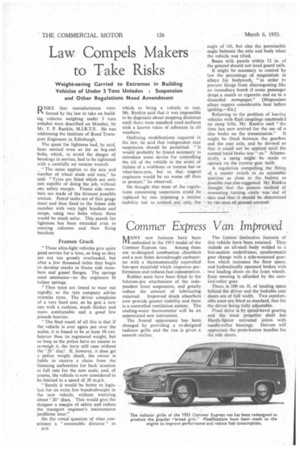Law Compels Makers to Take Risks
Page 56

If you've noticed an error in this article please click here to report it so we can fix it.
Weight-saving Carried to Extremes in Building Vehicles of Under 3 Tons Unladen : Suspension and Other Regulations Need Amendment
RISKS that manufacturers were 1Aforced by the law to take on building vehicles weighing under 3 tons unladen were described on Monday, by Mr. T. P. Rankin, M.I.R.T.E. He was addressing the Institute of Road Transport Engineers in Edinburgh.
The quest for lightness had, he said, been carried even as far as big-end bolts, which, to avoid the danger of breakage in service, had to be tightened with a carefully set torsion wrench.
" The same applies to the size and number of wheel studs and nuts," he said. "Tyres are fitted which are only just capable of doing the job, without este' safety margin. Frame side members are made of the thinnest possible section. Petrol tanks are of thin gauge sheet and then fixed to the frame side member with very light brackets and straps, using two bolts where three would be much safer. This search for lightness has been extended even to steering columns and their fixing brackets.
Frames Crack
"These ultra-light vehicles give quite good service for a time, so long as they are not too grossly overloaded, but after a few thousand miles they begin 10 develop cracks in frame side members and gusset flanges. The springs need assistance—so the engineers fit helper springs.
"Then tyres are found to wear out rapidly, so the tyre company advise oversize tyres. The driver complains of a very hard seat, so he gets a new one with a cushion, much thicker and mum comfortable and a good few pounds heavier.
" The final result of all this is that if the vehicle is ever again put over the scales, it is found to be at least 10 cwt. heavier than its registered weight, but so long as the police have no reason to re-weigh it, the lorry still runs without the ' 20' disc! If, however, it does get a police weight check, the owner is liable to receive a claim from the licensing authorities for back taxation at full rate for the new scale, and, of course, the vehicle is now considered to be limited to a speed of 20 m.p.h.
"Surely it would be better to legislate for an extra few hundredweight in the new vehicle, without worrying about '20' discs. This would give the designer a margin of safety and reduce the transport engineer's maintenance problems later."
On the vexed question of what constitutes a "reasonable distance" in zel6 which to bring a vehicle to rest, Mr. Rankin said that it was impossible to be dogmatic about stopping distances until there were standard road surfaces with a known value of adhesion in all weathers.
Outlining modifications required in the law, he said that independent rear suspension should be permitted. "It would probably be found necessary to introduce some device for controlling the tilt of the vehicle in the event of failure of a wishbone or torsion bar or what-have-you, but . in that respect engineers would be no. worse off than at present," he observed..
He thought that most of the regulations concerning suspension could be replaced by one imposing a stricter stability test to control not only the angle of tilt, but also the permissible angle between the axle and body when the vehicle was tilted.
Buses with panels within 12 in. of the ground should not need guard rails_ It might be necessary to control by law the percentage of magnesium in alloys for bodywork, "in order to prevent things from disintegrating like an incendiary bomb if some passenger drops a match or cigarette end on to a discarded newspaper." [Magnesium alloys require considerable heat before igniting.—ED.] Referring to the problem of leaving vehicles with fluid couplings unattended on steep hills, Mr. Rankin said " the time has now arrived for the use of a disc brake on the transmission." It might be fitted between the gearbox and the rear axle, and be devised so that it could not be applied until the normal hand brake was " on." Alternatively, a Sprag might be made to operate on the reverse gear teeth.
e A regulation compelling the fitting of a master switch in an accessible position as close to the battery as possible was also suggested. Mr. Rankin thought that the present method of measuring turning circle was •"out• of date and that it should be determined by the area of ground .covered.
































































































